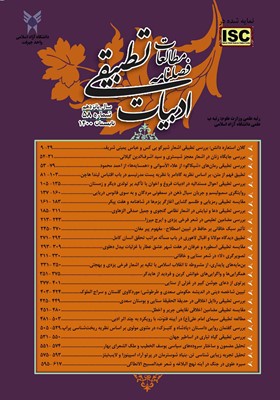تحلیل مضمون و ساختار سرودههای سیاسی یوسف الخطیب و ملک الشعرای بهار
محورهای موضوعی : شعرفاطمه معصومی شیخ احمد لویی 1 , کتایون فلاحی 2 , طاهره چالدره 3
1 - دانشجوی دکتری زبان و ادبیات عربی، واحد گرمسار، دانشگاه آزاد اسلامی، گرمسار، ایران
2 - استادیار گروه زبان و ادبیات عربی، واحد گرمسار، دانشگاه آزاد اسلامی، گرمسار، ایران
3 - استادیار گروه زبان و ادبیات عربی، واحد گرمسار، دانشگاه آزاد اسلامی، گرمسار، ایران
کلید واژه: یوسف الخطیب, ملک الشعرای بهار, ساختار, شعر, مضمون,
چکیده مقاله :
تحلیل ساختاری و محتوایی در زبان صرفاً نمایی روبنایی نیست، بلکه بر عکس بخش اساسی از معنای رسانده شده توسط شاعر را تشکیل میدهد. این نوع تحلیل، از میان گونههای کاربرد زبان، بیش از همه به زبان در ادبیات توجه نشان میدهد و بخش عمده پژوهشها در این شاخه مطالعاتی بر شناسایی سبکهای ادبی، زبان شخصی و فردیتِ خلّاق مولّف متمرکز است. یوسف خطیب از جمله شاعران سیاسی معاصر فلسطین میباشد که خود عضو حزب بعث سوسیالیستی عربی بود که فعالیّتهای سیاسی بسیاری از خود بر جای گذاشته است و دیوان شعری وی پُر از مفاهیم سیاسی پیرامون جهان عرب است که در وراء این اشعار بر عنصر مقاومت و پایداری تأکید دارد. شباهتهای مفاهیم شعری یوسف الخطیب و ملک الشعرای بهار نگارندگان را بر آن داشت تا اشعار این دو را از منظر محتوایی و ساختاری مورد بحث و بررسی قرار دهند. نگارندگان در پژوهش حاضر با رویکرد توصیفی- تحلیلی به بررسی و نقد دادهها میپردازند.
Structural and content analysis in language is not merely a superficial representation, but on the contrary, it is an essential part of the meaning conveyed by the poet. This type of analysis, among the types of language use, pays the most attention to language in literature, and most of the research in this branch of study focuses on identifying literary styles, personal language, and the individual creativity of the author. Yusef Khatib is one of the contemporary Palestinian political poets who were himself a member of the Ba'athist Arab Socialist Party, which has been active in many political activities. His poetry collection is full of political concepts about the Arab world that emphasizes the resistance and stability. The similarities between the poetic concepts of Yusuf al-Khatib and Malek al-Shoaraye Bahar led the writers to discuss their poems from a content and structural point of view. In the present study, the authors examine and critique the data with a descriptive-analytical approach.
کتابنامه
القرآن الکریم.
أبوشاور، سعدی. 2003م، تطور الإتجاهات الوطنیة فی الشعر الفلسطینی المعاصر، بیروت: المؤسسة العربیة للدراسات والنشر.
أحمد غنیم، کمال.1998م، عناصر الإبداع الفنّی فی شعر أحمد مطر، ط1، قاهرة: مکتبة مدبولی.
بهار، محمّدتقی. 1369ش، دیوان اشعار، تهران: انتشارات نگاه.
الخطیب، یوسف. 1959م، دیوان عائدون، بیروت: دار الآداب.
الخطیب، یوسف. 1998م، مجموعة بالشام أهلی والهوی بغداد، دمشق: دار فلسطین للثقافة والإعلام والفنون.
الخطیب، یوسف. 1998م، مجموعة رأیت الله فی غزّة، دمشق: دار فلسطین للثقافة والإعلام والفنون.
سلیمان، خالد. 1376ش، فلسطین و شعر معاصر عرب، ترجمه شهره باقری و عبدالحسین فرزاد، تهران: چشمه.
شفیعی کدکنی، محمدرضا. 1379ش، شاعر آیینهها(بررسی سبک هندی و شعر بیدل)، چاپ چهارم، تهران: آگاه.
شمیسا، سیروس. 1380ش، کلیات سبک شناسی، چاپ ششم، تهران: نشر فردوس.
عمید زنجانی، عباسعلی. 1390ش، مبانی اندیشه سیاسی در اسلام، چاپ هشتم، تهران: نشر پژوهشگاه فرهنگ و اندیشه اسلامی.
عمید، حسن. 1360ش، فرهنگ فارسی عمید، ج2، چاپ سوّم، تهران: امیرکبیر.
الفاخوری، حنّا. 1422ق، تاریخ الأدب العربی الحدیث، المجلد الثانی، چاپ چهارم، قم: ذوی القربی.
معین، محمد. 1386ش، فرهنگ فارسی معین، ج2، چاپ دوّم تهران: نشر ثامن.
میرزایی، نجفعلی. 1389ش، فرهنگ اصطلاحات معاصر، چاپ دوّم، تهران: نشر فرهنگ معاصر.
مقالات
بهروزی لک، غلامرضا. «درآمدی بر مسائل سیاسی دکترین مهدویت»، فصلنامه انتظار موعود، شماره 16.
تجلیل، جلیل و محمدتقی بیگلر. 1389ش، «بلاغت تصویر در دیوان اشعار محمدتقی بهار»، فصلنامه تخصصی ادبیات فارسی دانشگاه آزاد اسلامی مشهد، شماره 28، زمستان.
کنفانی، غسّان. 1968م، «ابعاد ومواقف من الأدب المقاومة الفلسطینیة»، بیروت، مجلة الآداب، العدد الرابع.
_||_The Holy Quran.
Abu Shawar, Saadi. 2003, The Evolution of Patriotic Developments in Contemporary Palestinian Poetry, Beirut: Arab Foundation for Studies and Publishing.
Ahmad Ghanim, Kamal. 1998, Anasor Al-Ebda Al-Fanni Fi Sher Ahmad Matr, V1, Cairo, Madbuli School
Bahar, Mohammad Taqi 1990, Poetry Divan, Tehran: Negah Publications.
Al-Khatib, Yusuf 1959, Diwan Aidoun, Beirut: Dar al-Adab.
Al-Khatib, Yusuf 1998, Balsham Ahl al-Wahwi Collection in Baghdad, Damascus: Dar Felestin Lelsaghafat Valelam Valfonun
Al-Khatib, Yusuf 1998, Ra'atullah Collection in Gaza, Damascus: Dar Palestine Lelsaghafat Valelam Valfonun.
Suleiman, Khalid 1997, Palestine and Contemporary Arab Poetry, translated by Shohreh Bagheri and Abdolhossein Farzad, Tehran: Cheshmeh.
Shafi'i Kadkani, Mohammad Reza 2000, The Poet of Mirrors (A Study of Indian Style and Bidel Poetry), Fourth Edition, Tehran: Agah.
Shamisa, Sirus. 2001, Generalities of Stylistics, sixth edition, Tehran: Ferdows Publishing.
Amid Zanjani, Abbas Ali 2011, Fundamentals of Political Thought in Islam, Eighth Edition, Tehran: Publication of the Institute of Islamic Culture and Thought.
Amid, Hasan, 1981, Amid Persian Dictionary, Volume 2, Third Edition, Tehran: Amirkabir.
Al-Fakhouri, Hanna. 1422 AH, History of Arabic Literature Hadith, Second Volume, Fourth Edition, Qom: Zuy Al-Ghorba.
Moein, Mohammad 2007, Farsi Dictionary of Moein, vol. 2, second edition of Tehran: Samen Publishing.
Mirzaei, Najafali 2010, Dictionary of Contemporary Terms, Second Edition, Tehran: Contemporary Culture Publishing.
Articles
Behrooz Lak, Gholamreza. "An Introduction to the Political Issues of the Doctrine of Mahdism", Quarterly Journal of the Promised Waiting, No. 16.
Tajlil, Jalil and Mohammad Taghi Bigler. 2010, "Image Rhetoric in Mohammad Taghi Bahar Poetry Divan", Quarterly Journal of Persian Literature, Islamic Azad University of Mashhad, No. 28, Winter. Kanfani, Ghassan. 1968, "Dimensions and positions of the literature of the Palestinian resistance", Beirut, Journal of Literature, Number Four.
Yousefi, Hadi and Abbas Hassani Jalilian. 2015, "Stylistic and rhetorical adaptation of the radiance of the beam in the poems" Prav "and" Diar Ashna "from the poems" Damavandieh "and" Speed Road "of Malek Al-Shoaraye Bahar", Quarterly Journal of Literary and Rhetorical Research, Volume 3, Number 12, pp. 84-66.


